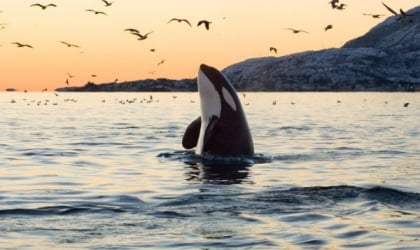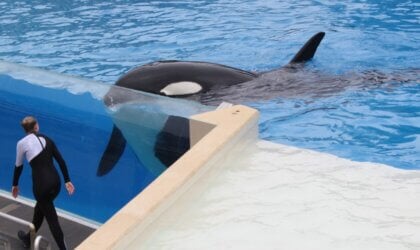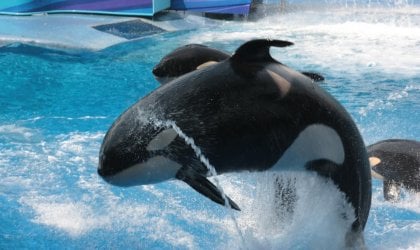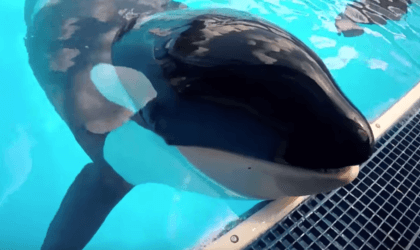SeaWorld confines whales and dolphins to small concrete tanks at marine abusement parks across the country, where they slowly go insane from stress and frustration. To create generations of animals the company can exploit for profit, staff sexually abuse and impregnate dolphins and whales, sometimes after drugging them. Often housed with incompatible tankmates, orcas and other animals are regularly drugged in order to manage stress-induced aggressive behavior and relieve the endless monotony of swimming in circles. They break their teeth chewing on the metal bars and concrete sides of their tanks, and they’re coerced into performing tricks for tourists in exchange for food—all in the name of entertainment. It’s a business built on the suffering of intelligent, social animals who are denied everything that’s natural and important to them.
SeaWorld Is a Hellhole for Animals
Abducted. Forcibly bred. Trapped. Made to perform. If this happened to a human, no one would stop until they were safe.SeaWorld is closed for the coronavirus and we think it should STAY CLOSED. PETA won’t stop until all the animals at SeaWorld are released to seaside sanctuaries
Posted by PETA (People for the Ethical Treatment of Animals) on Wednesday, March 11, 2020
SeaWorld—which confines all but one of the captive orcas in the U.S.—has a long history of exploiting animals. In nature, orcas work cooperatively in search of food and share complex relationships in a matrilineal society. They have group-specific food preferences, behavior, and unique dialects, which are considered a form of culture that’s unrivaled by any species other than humans. Free orcas are also among the fastest animals in the sea—they can swim as far as 140 miles in a day and dive deep. But at SeaWorld, orcas who’ve been torn away from their families have nothing to do but swim in endless circles inside barren tanks.

More than 40 orcas have died at SeaWorld—many far short of their natural life expectancy—from causes such as bacterial infections and fractured skulls. More than 500 other dolphins and whales, approximately 400 pinnipeds, and countless other animals have also died at the parks. In nature, dolphins maintain dynamic relationships within a large social network, living with up to 1,000 others in a pod, and choose their own mates. But at SeaWorld, they’re often housed in incompatible groups where they can’t escape attacks from frustrated, aggressive dolphins.
Bottlenose dolphins are used as breeding machines to create generation after generation of animals imprisoned for life. Male dolphins are masturbated, and females are torn out of the water and sometimes drugged so they can’t fight back while staff shove tubes filled with semen into their uteruses. Some have been repeatedly impregnated, only to lose their babies. And while bottlenose dolphins can swim up to 60 miles each day and dive to depths of nearly 1,500 feet, at SeaWorld, 140 of them are crammed into just seven chemically treated concrete tanks that, to them, are the equivalent of bathtubs.
What PETA Is Doing to Save the Whales and Other Animals at SeaWorld
To help whales, dolphins, and other animals trapped at SeaWorld, PETA uses a variety of tactics, including billboards, demonstrations, complaints to law-enforcement officials, corporate negotiations, shareholder activism, litigation, and celebrity engagement.

During Orlando’s reopening on Thursday, June 11, a crying “dolphin” reminded passersby that SeaWorld breeds for greed and the easiest way to show support for animals is to boycott all marine parks.

A beluga whale billboard PETA erected in response to a similar billboard advertising SeaWorld
In 2013, the documentary Blackfish was released to critical acclaim and became an instant phenomenon, causing stars such as Willie Nelson and Martina McBride to cancel concerts at SeaWorld, schools to cancel field trips there, and park attendance to drop. The film exposed the company’s horrific capture of young orcas in the ocean, the misery of their lifetime confinement, and how this cruelty led the frustrated orca Tilikum—who died after 33 years in a concrete prison—to kill three humans, even though orcas in nature have never hurt a human.
Since Blackfish, four of SeaWorld’s CEOs have resigned and more than 1,200 of its employees have been laid off. Dozens of its corporate partners—including Snickers, TripAdvisor, Airbnb, Booking.com, Alaska Airlines, JetBlue, Mattel, Southwest Airlines, STA Travel, and Taco Bell—have severed ties with the company.
The corporation has faced more than half a dozen lawsuits from shareholders, including a securities class-action lawsuit alleging that it misled investors about the impact of Blackfish and the unethical treatment of the orcas at its parks. The company and its former CEO paid $5 million to settle fraud charges brought by the U.S. Securities and Exchange Commission for misleading investors regarding the documentary’s effect on the company. Internal e-mails show that executives were sharing a confidential spreadsheet titled “Lost Blackfish Revenue” nearly eight months before they finally admitted to investors that the documentary was having an impact.
In 2016, faced with plunging stock prices and impending state and federal legislation to ban orca breeding, SeaWorld was forced to end its own sordid orca-breeding program—a practice that has since been made illegal in California—because, according to its now-former CEO:
“[T]he data and trends showed it was either a SeaWorld without whales or a world without SeaWorld.”
SeaWorld knows that its remaining customers come for the new rides, concerts, and other forms of amusement that don’t harm animals. In February 2020—after a months-long PETA campaign—SeaWorld was forced to stop allowing trainers to stand on dolphins’ faces and ride on their backs in cruel circus-style shows.
 © dreamstime.com/Paul Brewster
© dreamstime.com/Paul BrewsterSeaWorld finally listened to PETA and will stop using dolphins as surfboards. Trainers will no longer stand on dolphins’ faces or surf on them in circus-style shows.
SeaWorld claims that it’s committed to “protecting and conserving animals worldwide,” but in 2018, its publicly funded conservation fund only spent the equivalent of about 2.2% of the company’s profits. True conservation is about helping animals in their own environment, not imprisoning them for entertainment.
PETA is urging SeaWorld to modernize its business by ending its sordid dolphin- and whale-breeding programs and relocating the animals to seaside sanctuaries, where they can thrive in the enrichment and diversity of the sea while still receiving care, food, and veterinary support.
SeaWorld teaches the public the wrong lesson: that animals are ours to do with as we please, which perpetuates speciesism, a human-supremacist worldview.
Help PETA Save the Whales and Dolphins at SeaWorld
You can help save the whales, dolphins, and other animals held captive by SeaWorld! Please never buy a ticket to the parks or support the business in any other way.




